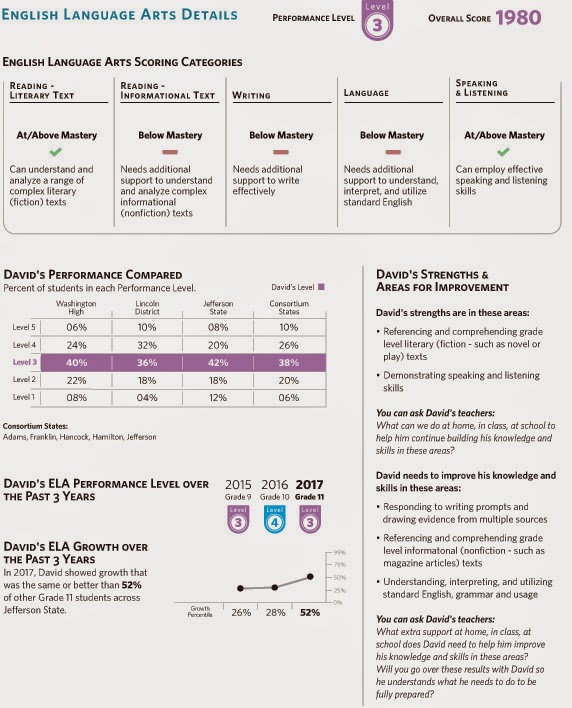Curmudgucation: Your Granular Achievement Report
Remember how we need standardized testing so that parents can have a complete picture of just how well their child is doing in school? Well, the folks at achieve.org have whipped up a sample of what that carefully nuanced, deeply granulated report will look like. Let's check it out.
Actually, said out-checking won't take very long. The hyper-granulous ELA report for a hypothetical 11th grader of 2017 is just two pages long. It does have pretty graphics, but, well...
The first 1/3 page is a "how to read this" explanation that does an excellent job of...um...taking up space?
Then we get to David's first score. It's a 1980 out of 2400, which makes him Level 3 (there's a cool badge graphic just in case you're unsure of that number) and an explanation of Level 3 so that parents can impactfully appreciate the granulosity of this nuanced report. Here, in its entirety, is the explanation of Level 3:
Students who score in Level 3 show Moderate Understanding of the expectations for their grade and are likely to need additional support to be fully prepared for English in the next English course. They may need remediation for reading, writing, speaking and listening in college and careers after high school. These students should talk to their teachers and counselors about how to get extra help and course selection for the remainder of high school.
So, David did medium well on language and might need to get better at some stuff having to do with some sort of language use. Go to the office and ask, David's parents, because you might not be ready for college because of stuff, and things. And clearly, the only possible thing parents could ever want to know about a student is whether he's on the path to college or not.
And that's page one.
Page two tries to granulate things a bit more. We break language into five whole areas: Reading Literary Text, Reading Informational Text, Writing, Language and Speaking/Listening. For each David gets a ranking of above, at or below mastery. So, granules!
There are also some fun graphs that show how David compares within the district and within the testing consortium. Just in case you want to know whether to brag or be ashamed.
And there's a column offering strengths and weaknesses. One of David's strengths is "Demonstrating speaking and listening skills" (which leads me to really wonder what this future standardized test is going to look like). One of his weaknesses is "Understanding, interpreting and utilizing standard English, grammar and usage." If those don't seem like quite enough detail, the sheet also offers advice about what to ask your teachers or guidance counselors. What you can ask is a fancy version of, "What could we do so that David would be better." So you're welcome for that big piece of assistance, parents.
And that is it. This is somehow worth our great national testing nightmare, because parents will enjoy such massive benefits from this form that tells them "Your kid got about a C, because reasons. And stuff." Clearly this is so much deeper than what any report card or regular papers sent home or conversation with a live human teacher could ever be.
Mostly I just want to create a t-shirt that says "I paid billions of tax dollars for a deeply nuanced granulated standardized test, and all I got was this lousy two page report." But I can see one other method to the test-developers madness. With reports this vague and useless, it would not be necessary to actually score the complete tests. Hell, you could crank these reports out just plugging in student names with randomly generated results, and you would probably be close to correct most of the time. The savings and increased revenue for the testing companies would be considerable.
This blog post has been shared by permission from the author.
Readers wishing to comment on the content are encouraged to do so via the link to the original post.
Find the original post here:
The views expressed by the blogger are not necessarily those of NEPC.


